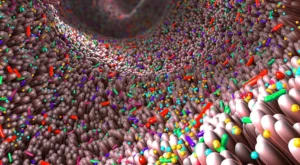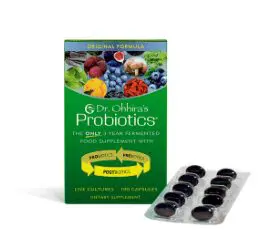Most people have heard of probiotics these days. Probiotics are helpful microorganisms that offer benefits to the human body. The collection of friendly bacteria, viruses, and yeasts that live in our bodies is collectively called the human microbiome.
Probiotic supplements are very prevalent today. The global market size in 2024 is $5.56 billion and growing. In addition to the many supplements on the market, many food and health product manufacturers now add probiotics to foods and body care products.
Along with probiotics, there has been a great deal of focus on prebiotics and postbiotics. These are companion substances to probiotics. What are these pieces of the probiotic equation? How do they affect the body? When do you take them?
Read on to understand the healthy probiotic trio and how to use it effectively.
The Probiotic Trinity: Probiotics, Prebiotics, and Postbiotics
While most people understand probiotics, prebiotics and postbiotics came on the scene more recently. Here is a short explanation of the three elements.
Probiotics
Human bodies naturally host a multitude of friendly and unfriendly microorganisms. These live in our gut, mouth, nose, lungs, skin, and urogenital system, going about their business. When our microbiome is well balanced, the friendly bacteria predominate, keeping unfriendly bacteria levels down, and we feel at our healthiest.
However, we live in a world where stress, pollution, refined foods, and medications – especially antibiotics – can reduce the number of friendly microorganisms throughout our bodies, enabling unfriendly or pathogenic bacteria to grow and causing negative responses in the body. To offset these impacts, we can eat foods like yogurt, kefir, sauerkraut, kimchi, miso, tempeh, and tofu to add probiotics to our diet, or we can take a probiotic supplement.
Researchers from the late 19th century through today have experimented with probiotics and have found positive correlations between probiotic consumption and health. Research continues as scientists look for the strains of bacteria most helpful for specific conditions.
Probiotics are generally considered safe, but if you plan to start taking them, it’s always a good idea to talk with your doctor, especially if you are immune-compromised or have recently had surgery or a hospital stay.
Prebiotics
Prebiotics are foods that feed the helpful bacteria. They contain fermentable soluble fiber, and while we can’t digest it, probiotics love it. Prebiotic foods either contain resistant starches, inulin, or pectin. Boiled, chilled potatoes, green bananas, legumes, rice, oats, and barley contain resistant starches. Asparagus, garlic, leeks, onions, soybeans, and wild yams contain inulin. Many fruits, such as apples, carrots, peaches, raspberries, and apricots, contain pectin.
Consuming prebiotics in food or supplement form gives the probiotics the foods they need to thrive, and in return, their activity produces the compounds that keep our bodies healthy.
Postbiotics
The third element in our probiotic trinity is postbiotics. As the friendly microorganisms go about their business in and on our bodies, they consume the prebiotics, producing compounds – postbiotics – that are helpful for human health.
Postbiotics are a product of probiotic microorganisms, but they provide elements essential for human health, including short-chain fatty acids, enzymes, vitamins, amino acids, and other compounds. Postbiotics are also available in supplement form, which can boost your friendly bacteria.
FAQs on How to Take Prebiotic & Postbiotic Supplements
What is the difference between probiotic and prebiotic supplements?
A probiotic supplement contains live active cultures of friendly bacteria. A prebiotic supplement includes a concentration of the foods the friendly bacteria like to eat to stimulate their growth in the digestive tract. Prebiotics contain no live bacteria.
When Is the best time to take prebiotics?
The best time of day to take probiotics and prebiotics is when you will remember to do it. While timing sometimes increases effectiveness, consistency is more important.
Should you take prebiotics in the morning or at night?
While you can take probiotics and prebiotics at any time, probiotics have a greater survival rate in the morning, about 30 minutes before a meal, because your stomach is less acidic.
Can I take probiotics and prebiotics together?
Taking a probiotic and a prebiotic together is called synbiotic therapy because it has a synergistic effect, meaning the two are more effective together than individually. However, you could experience gas, indigestion, belly pain, or bloating for a few days as you start prebiotics. In this case, you may consider taking your probiotic in the morning and the prebiotic at night until your symptoms subside.
Should I take a prebiotic with meals?
No scientific studies conclude that taking prebiotics with or without food is better. However, taking them with food is more like consuming prebiotic foods and may be more readily accepted by our bodies. Our digestive systems do not break down prebiotics, so taking them with food does not affect how our bodies deal with them.
Should you eat prebiotics before probiotics?
When you take probiotics and prebiotics simultaneously, scientists call them synbiotics because they are more effective together than taken separately.
As mentioned, consistency is crucial in taking probiotics and prebiotics. How to take prebiotics and probiotics is not as important as making sure you take them every day. Taking them together can boost their effects, but you can also take them separately.
Can you take two probiotics a day?
Supplements that combine multiple probiotics are best for boosting digestive tract microbiome diversity. Follow the manufacturer’s instructions on how often to take your probiotic.
What is the best prebiotic, probiotic and postbiotic combination?
When considering the best prebiotic and probiotic combination, look for multiple strains of friendly bacteria for optimum gut bacteria diversity. At Dr. Ohhira’s, our probiotics contain probiotics, prebiotics, and postbiotics, giving you the most significant impact from your probiotic supplement.
How to Choose a Quality Probiotic
The benefits of the probiotic trinity – probiotics, prebiotics, and postbiotics – are attracting much attention in medical circles because of their results when used together. As you evaluate your choices for a probiotic supplement, here are a few essential elements to consider:
- Make sure your probiotic has multiple strains for maximum diversity in the digestive tract
- Choose a supplement that contains probiotics, prebiotics, and postbiotics for a synbiotic effect
- Check the label to make sure there are no allergens such as gluten or dairy
- Check with the manufacturer and ensure the product does not contain chemicals, additives, preservatives, colorings, or flavorings
- Make sure the product is shelf-stable and can survive stomach acids
A Few Final Thoughts
At Dr. Ohhira’s, we combine ancient Japanese wisdom with up-to-the-minute scientific information to create effective probiotic products. We culture our probiotics at a natural temperature in large vats for three years, introducing 13 probiotic strains for a balanced product.
The different probiotics learn how to co-exist as they will need to do in your digestive tract. We feed them natural plant crops seasonally, and by ingesting these prebiotics, they produce the postbiotics that are so beneficial for human health.
Visit our website to learn more or order online. You can also contact us with any questions or call us at 972-255-3918.




